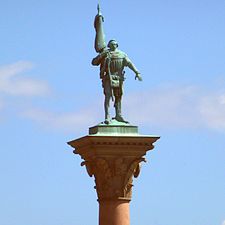Engelbrekt Engelbrektsson
The background was the widespread discontent against the king's bailiff in Västerås, Jösse Eriksson [sv], who was blamed for the distress that mining men suffered under his rule.
[5] Jösse Eriksson returned to Sweden the same year, but was lynched by peasants in Motala after presenting him to the local thing who condemned him to death.
[6][7] Over the next few decades Engelbrekt became a national hero, depicted as a public protector and an opponent of the Kalmar Union.
His rebellion came to be seen as the start of the Swedish national awakening, which would triumph in the following century with the victory of King Gustav Vasa (reigned 1523–1560).
Engelbrekt himself had no such ideas, which must have been anachronistic at the time; however his rebellion gave peasants a voice in Swedish politics which they never lost afterwards.
The Engelbrekt rebellion caused the unity of the Kalmar Union to erode, leading to the expulsion of Danish forces from Sweden.
Although later Danish kings regained influence over Sweden, the rebellion had set a precedent for Swedish claims to sovereignty.


